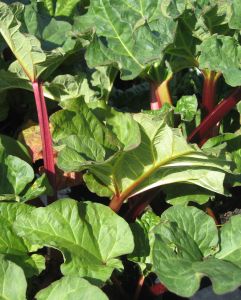Tartness of rhubarb and the sweetness of strawberries can make a flavorful jelly
How to make homemade rhubarb-strawberry jelly.
June is considered the season for rhubarb in Michigan. Rhubarb was once considered a vegetable, but in 1947 a New York court ruled it as a fruit for tax regulations. Rhubarb leaves contain oxalic acidwhich is poisonous and should not be eaten. Only the stems of rhubarb are edible. It is recommended to gently twist the rhubarb stems so that you don’t damage the plant when picking rhubarb. Rhubarb stalks can grow 12 to 18 inches and are green to dark red in color. Rhubarb can be stored in the refrigerator or frozen to be used later.
was once considered a vegetable, but in 1947 a New York court ruled it as a fruit for tax regulations. Rhubarb leaves contain oxalic acidwhich is poisonous and should not be eaten. Only the stems of rhubarb are edible. It is recommended to gently twist the rhubarb stems so that you don’t damage the plant when picking rhubarb. Rhubarb stalks can grow 12 to 18 inches and are green to dark red in color. Rhubarb can be stored in the refrigerator or frozen to be used later.
Rhubarb is considered a source of vitamin A and C, calcium and potassium. Rhubarb has only 29 calories a serving and with sugar, 139 calories per serving. By adding sweet fruit such as strawberries you can increase the sweetness of rhubarb.
Below is a rhubarb jelly recipe.
Strawberry-Rhubarb Jelly
- 1 1/2 pounds red stalks of rhubarb
- 1 1/2 quarts ripe strawberries
- 1/2 teaspoon butter or margarine
- 6 cups sugar
- 6 ounces liquid pectin
Procedure:
Wash and cut rhubarb into one inch pieces and blend or grind. Wash, remove stems and crush strawberries, one layer at a time in a sauce-pan. Place both fruits in a jelly bag, or double layer of cheesecloth and gently squeeze out juice. Measure 3 1/2 cups of juice into a large saucepan. Add butter and sugar, thoroughly mixing into juice. Bring to a boil over high heat, stirring constantly. Immediately stir in pectin. Bring to a full, rolling boil and boil hard for one minute, stirring constantly. Remove from heat, quickly skim off foam and fill sterile jars, leaving one inch headspace. Wipe rims of jars with a dampened, clean paper towel. Adjust lids and process. Pints or half pints should be processed for five minutes at altitudes of 1,000 feet and below, or 10 minutes at 1,000 to 6,000 feet above sea level.
Source: National Center for Home Food Preservation
For additional information on preserving Michigan produce and food safety please view the Michigan State University Extension making jams and jellies video.



 Print
Print Email
Email




